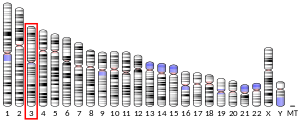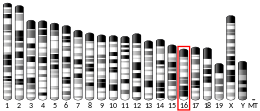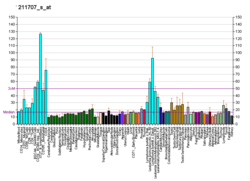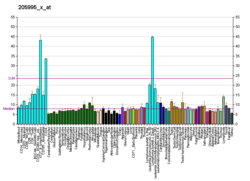IQCB1
IQ calmodulin-binding motif-containing protein 1 is a protein that in humans is encoded by the IQCB1 gene.[5][6]
References
- GRCh38: Ensembl release 89: ENSG00000173226 - Ensembl, May 2017
- GRCm38: Ensembl release 89: ENSMUSG00000022837 - Ensembl, May 2017
- "Human PubMed Reference:". National Center for Biotechnology Information, U.S. National Library of Medicine.
- "Mouse PubMed Reference:". National Center for Biotechnology Information, U.S. National Library of Medicine.
- Otto EA, Loeys B, Khanna H, Hellemans J, Sudbrak R, Fan S, Muerb U, O'Toole JF, Helou J, Attanasio M, Utsch B, Sayer JA, Lillo C, Jimeno D, Coucke P, De Paepe A, Reinhardt R, Klages S, Tsuda M, Kawakami I, Kusakabe T, Omran H, Imm A, Tippens M, Raymond PA, Hill J, Beales P, He S, Kispert A, Margolis B, Williams DS, Swaroop A, Hildebrandt F (Feb 2005). "Nephrocystin-5, a ciliary IQ domain protein, is mutated in Senior-Loken syndrome and interacts with RPGR and calmodulin". Nat Genet. 37 (3): 282–8. doi:10.1038/ng1520. PMID 15723066.
- "Entrez Gene: IQCB1 IQ motif containing B1".
Further reading
- Nomura N, Miyajima N, Sazuka T, et al. (1995). "Prediction of the coding sequences of unidentified human genes. I. The coding sequences of 40 new genes (KIAA0001-KIAA0040) deduced by analysis of randomly sampled cDNA clones from human immature myeloid cell line KG-1". DNA Res. 1 (1): 27–35. doi:10.1093/dnares/1.1.27. PMID 7584026.
- Nomura N, Miyajima N, Sazuka T, et al. (1995). "Prediction of the coding sequences of unidentified human genes. I. The coding sequences of 40 new genes (KIAA0001-KIAA0040) deduced by analysis of randomly sampled cDNA clones from human immature myeloid cell line KG-1 (supplement)". DNA Res. 1 (1): 47–56. doi:10.1093/dnares/1.1.47. PMID 7584028.
- Bonaldo MF, Lennon G, Soares MB (1997). "Normalization and subtraction: two approaches to facilitate gene discovery". Genome Res. 6 (9): 791–806. doi:10.1101/gr.6.9.791. PMID 8889548.
- Mollet G, Salomon R, Gribouval O, et al. (2002). "The gene mutated in juvenile nephronophthisis type 4 encodes a novel protein that interacts with nephrocystin". Nat. Genet. 32 (2): 300–5. doi:10.1038/ng996. PMID 12244321.
- Strausberg RL, Feingold EA, Grouse LH, et al. (2003). "Generation and initial analysis of more than 15,000 full-length human and mouse cDNA sequences". Proc. Natl. Acad. Sci. U.S.A. 99 (26): 16899–903. doi:10.1073/pnas.242603899. PMC 139241. PMID 12477932.
- Gerhard DS, Wagner L, Feingold EA, et al. (2004). "The status, quality, and expansion of the NIH full-length cDNA project: the Mammalian Gene Collection (MGC)". Genome Res. 14 (10B): 2121–7. doi:10.1101/gr.2596504. PMC 528928. PMID 15489334.
- Mollet G, Silbermann F, Delous M, et al. (2005). "Characterization of the nephrocystin/nephrocystin-4 complex and subcellular localization of nephrocystin-4 to primary cilia and centrosomes". Hum. Mol. Genet. 14 (5): 645–56. doi:10.1093/hmg/ddi061. PMID 15661758.
- le Maire A, Weber T, Saunier S, et al. (2006). "Solution NMR structure of the SH3 domain of human nephrocystin and analysis of a mutation-causing juvenile nephronophthisis". Proteins. 59 (2): 347–55. doi:10.1002/prot.20344. PMID 15723349.
- Luo X, He Q, Huang Y, Sheikh MS (2006). "Cloning and characterization of a p53 and DNA damage down-regulated gene PIQ that codes for a novel calmodulin-binding IQ motif protein and is up-regulated in gastrointestinal cancers". Cancer Res. 65 (23): 10725–33. doi:10.1158/0008-5472.CAN-05-1132. PMID 16322217.
This article is issued from Wikipedia. The text is licensed under Creative Commons - Attribution - Sharealike. Additional terms may apply for the media files.





